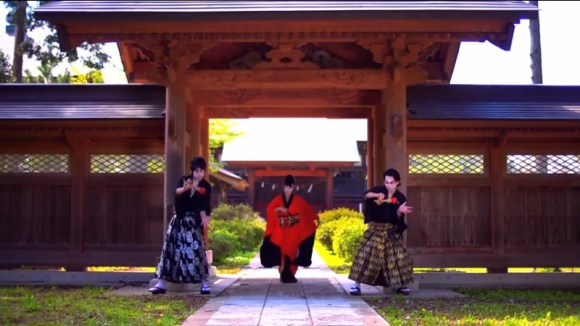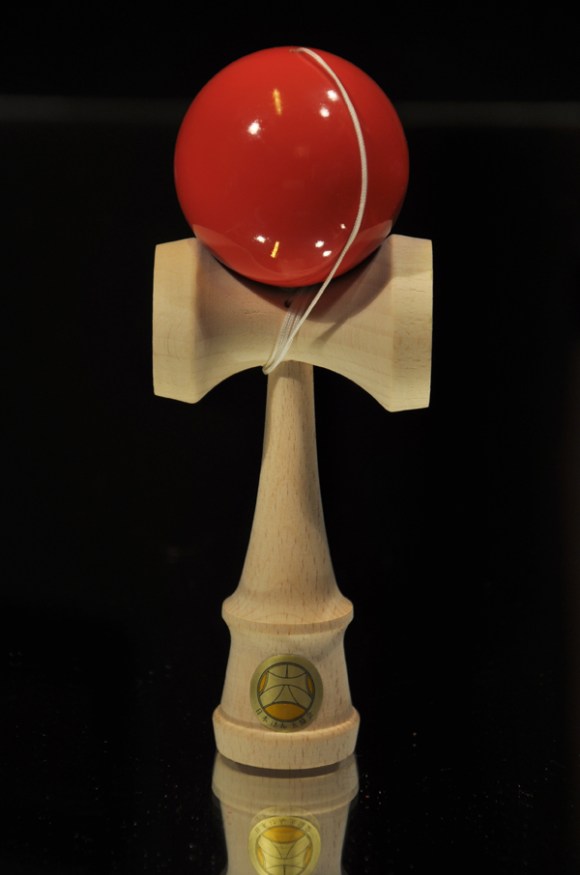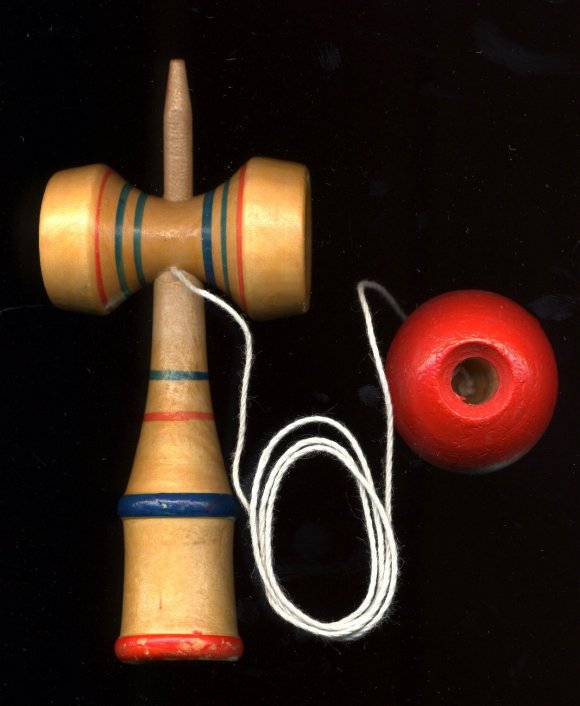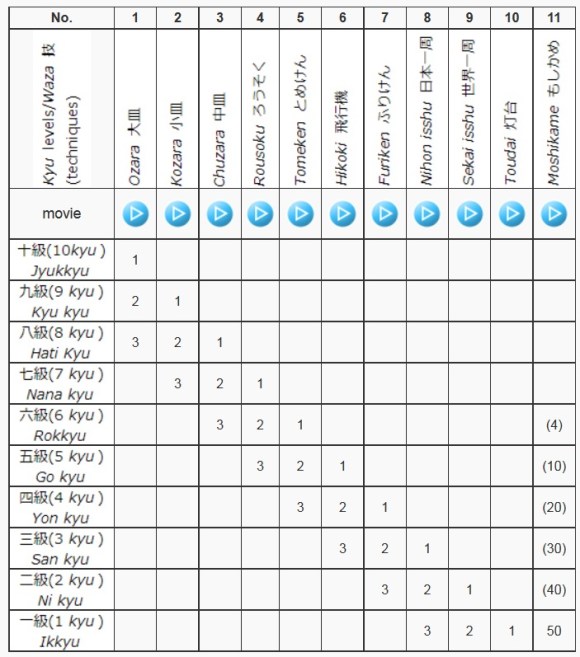
The other day, I was trawling through YouTube looking for shamisen music videos when I came across an utterly unique video called “Tokyo Kendama Project vol.2 Utakata.”
It featured the traditional Okinawan sansen three-stringed instrument played by the mysterious Gosamaru and composed by Tomoaki Ogre, the beautiful dancing of Kumi Arikawa, and a pair of strangely hypnotic gentlemen spinning some… things through the air. I’d heard of kendama before, as I imagine most people with even a fleeting knowledge of Japan have, but I’d never seen the toy wielded with such incredible finesse.
Fascinated, I had to know more!
- So, just what the heck is kendama?
Well, the simple answer is this:
▼A wooden kendama, approved for tournament use
▼A traditional kendama toy
As you can tell from the pictures, a kendama is a large ball on a string attached to a larger body called the ken, which is usually wooden. The ken has a spike on one end, flanked by two cups. The cups are of different sizes, with the larger cup called the ozara and the smaller cup called the kozara. Finally, there’s another cup on the bottom of the ken called the chuuzara.
Alright, so that’s that toy…but what do you do with it?
Probably most of you have played a cup-and-ball game at some point in your life, or at least seen one in a toy store. The basics are similar: get the ball into a cup. Simple, right?
Not at all!
▼A kendama master showing just how not simple it is!
- Playing kendama
Though the very basic tricks of kendama aren’t necessarily complicated, they do involve a lot of skill. Just popping the ball into a cup isn’t necessarily difficult to do, but it’s also not exactly easy by any means.
The Japan Kendama Association has a series of rankings for kendama enthusiasts as a way for measuring their progress. The lowest level involves letting the ball dangle from the ken and then snapping it upwards to catch it in the large cup. Do that once and you can pass the first level! Congratulations!
Obviously, as you move up, the tricks become more complicated, such as the “Around the Block,” where a kendama player pops the ball from the big cup to the small cup to the cup at the base of the ken. Kind of hard to visualize, so here’s a video!
▼The first trick demonstrated here is “Around the Block.”
Of course, rising through the ranks of kendama all by yourself would probably get old after a while. Which is why it’s good that there are regular competitions!
- Kendama…tournaments?
As with almost anything humans do, it eventually becomes necessary to find out who’s the best! And kendama is no different. The Japan Kendama Association offers regular tournaments with age groups from elementary students all the way to adults. The tournaments feature two players facing off at a time. After drawing a trick name from a box, one player will perform the trick as the other watches. Then, they switch. The first person to fail a trick gets knocked out, while the other moves up the ladder.
▼Semifinalist bout from the 2012 National Japan Kendama Championship.
Imagine how nerve-wracking it must be to sit and watch your opponent do a trick, waiting for them to mess up! I’d probably have a heart attack.
However, tournaments aren’t confined to Japan!
- Kendama goes international
While kendama seems to have originally arisen out of an imported European game, contemporary kendama is certainly a very Japanese pastime and has been for centuries. All that is starting to change, though, as the game garners more and more international attention.
In fact, kendama groups have sprung up all around the world—though primarily in North America and Europe. Curious to see what the kendama scene was like outside of Japan, I contacted some overseas associations.
The head of the British Kendama Association and two-time British Kendama Champion who goes by the name, The Void, was kind enough to answer some questions.
First, I wanted to know how he discovered this game. To be honest, I had no idea how far it had stretched outside of Japan, so I was surprised to learn that a British Kendama Association even existed.
Via an email interview, The Void explained, “I had two introductions. The first was a workshop run by a juggler who spoke Japanese, teaching us the basic 10 moves or so. About 18 months later I discovered a bunch of videos of Japanese players doing amazing tricks. It was the variety of tricks and possibilities displayed by these experts that really got me hooked.”
▼Tricks necessary for the 2012 British Kendama Open
Fair enough! But what did people think when they first saw kendama? I imagine the average British person doesn’t often come across this Japanese game.
“It can vary from complete indifference, to a heckle about ‘cup-and-ball,’ to curiosity and interest. Things immediately change when people actually have a go and realise that it’s a bit trickier than they first thought and that there are a lot of moves that they can learn,” he wrote.
I was also surprised to learn from The Void that kendama seems to be experiencing a bit of a growth spurt in the western world, particularly in the US and Denmark. Obviously, Britain and other European countries have growing groups as well. There’s even a European Kendama Open Championship!
▼The first Tokyo Kendama Project video
- Getting started with kendama
So, let’s say you’re interested in learning to play this game. How do you get started?
First, you obviously need to get a kendama! If you live in the US, you might want to check out Kendama USA, a website with official tournament kendama, videos of pro players, and a brief introduction to the game. In Europe, you obviously want to check out the British Kendama Association‘s website, where you can get kendamas and find a wealth of information on the game. There’s also a forum if you’re looking for a community to interact with. In Japan, you should probably take a look at the Japan Kendama Association, which is in charge of the basic skill categories and tournaments of kendama.
▼A speed demonstration of ten kendama tricks. For motivation!
I asked The Void what beginners could expect from kendama.
He wrote back, “Expect addiction! The simplest Big Cup catch will be a little harder than you first think, but stick with it, and you’ll get it… and discover that you are smiling.” He also gave me some advice for playing the game. “The best advice for 99 percent of kendama tricks can be summed up in 2 simple phrases: 1) Always make your catches downwards! 2) Use your knees!”
Another great thing about kendama is that it’s pretty good exercise. Though you wouldn’t think it from watching, the constant up and down of catching and tossing the ball really gets your heart pumping! Though I was also assured that you “don’t need to be an athlete to get good at kendama.”
▼Basic skill levels of kendama set by the Japan Kendama Association
- Let’s do this!
Now that you’ve seen all the videos and read a little bit about the game, are you ready to get started? If so, check out some of the websites below to get your own kendama!
Kendama associations and online stores: Japan Kendama Association, International Kendama Association, British Kendama Association, Kendama USA





 New kendama featuring Hello Kitty makes the traditional Japanese game super cute!
New kendama featuring Hello Kitty makes the traditional Japanese game super cute! Kendama master takes the game to a whole new level 【Video】
Kendama master takes the game to a whole new level 【Video】 Beautiful Japanese actress’ mediocre ball-on-a-stick skills have Internet crushing hard【Video】
Beautiful Japanese actress’ mediocre ball-on-a-stick skills have Internet crushing hard【Video】 Japanese traditional toy kendama is about to evolve into Dendama
Japanese traditional toy kendama is about to evolve into Dendama Meet Takeshi Kamisato, Hawaii’s “koma” spinning top and yo-yo master 【Video】
Meet Takeshi Kamisato, Hawaii’s “koma” spinning top and yo-yo master 【Video】 McDonald’s new Happy Meals offer up cute and practical Sanrio lifestyle goods
McDonald’s new Happy Meals offer up cute and practical Sanrio lifestyle goods All-you-can-drink Starbucks and amazing views part of Tokyo’s new 170 meter-high sky lounge
All-you-can-drink Starbucks and amazing views part of Tokyo’s new 170 meter-high sky lounge Studio Ghibli glasses cases let anime characters keep an eye on your spectacles
Studio Ghibli glasses cases let anime characters keep an eye on your spectacles Beautiful Sailor Moon manhole cover coasters being given out for free by Tokyo tourist center
Beautiful Sailor Moon manhole cover coasters being given out for free by Tokyo tourist center Kyoto’s 100 Demons yokai monster parade returns!
Kyoto’s 100 Demons yokai monster parade returns! Super Nintendo World expansion gets delayed for several months at Universal Studios Japan
Super Nintendo World expansion gets delayed for several months at Universal Studios Japan Massive-variation new Pikachu plushie line lets you find the perfect Pikachu just for you
Massive-variation new Pikachu plushie line lets you find the perfect Pikachu just for you Mister Donut ready to make hojicha dreams come true in latest collab with Kyoto tea merchant
Mister Donut ready to make hojicha dreams come true in latest collab with Kyoto tea merchant The oldest tunnel in Japan is believed to be haunted, and strange things happen when we go there
The oldest tunnel in Japan is believed to be haunted, and strange things happen when we go there A visit to the best UFO catcher arcade in the universe!
A visit to the best UFO catcher arcade in the universe! Disney princesses get official manga makeovers for Manga Princess Cafe opening in Tokyo
Disney princesses get official manga makeovers for Manga Princess Cafe opening in Tokyo More foreign tourists than ever before in history visited Japan last month
More foreign tourists than ever before in history visited Japan last month Starbucks reopens at Shibuya Scramble Crossing with new look and design concept
Starbucks reopens at Shibuya Scramble Crossing with new look and design concept Beautiful new Final Fantasy T-shirt collection on the way from Uniqlo【Photos】
Beautiful new Final Fantasy T-shirt collection on the way from Uniqlo【Photos】 Is the new Shinkansen Train Desk ticket worth it?
Is the new Shinkansen Train Desk ticket worth it? Foreign English teachers in Japan pick their favorite Japanese-language phrases【Survey】
Foreign English teachers in Japan pick their favorite Japanese-language phrases【Survey】 Japanese convenience store packs a whole bento into an onigiri rice ball
Japanese convenience store packs a whole bento into an onigiri rice ball We try out “Chan Ramen”, an underground type of ramen popular in the ramen community
We try out “Chan Ramen”, an underground type of ramen popular in the ramen community Studio Ghibli releases Kiki’s Delivery Service chocolate cake pouches in Japan
Studio Ghibli releases Kiki’s Delivery Service chocolate cake pouches in Japan Japan’s bone-breaking and record-breaking roller coaster is permanently shutting down
Japan’s bone-breaking and record-breaking roller coaster is permanently shutting down New definition of “Japanese whiskey” goes into effect to prevent fakes from fooling overseas buyers
New definition of “Japanese whiskey” goes into effect to prevent fakes from fooling overseas buyers Our Japanese reporter visits Costco in the U.S., finds super American and very Japanese things
Our Japanese reporter visits Costco in the U.S., finds super American and very Japanese things Studio Ghibli unveils Mother’s Day gift set that captures the love in My Neighbour Totoro
Studio Ghibli unveils Mother’s Day gift set that captures the love in My Neighbour Totoro Foreign passenger shoves conductor on one of the last full runs for Japan’s Thunderbird train
Foreign passenger shoves conductor on one of the last full runs for Japan’s Thunderbird train Domino’s Japan now sells…pizza ears?
Domino’s Japan now sells…pizza ears? New Japanese KitKat flavour stars Sanrio characters, including Hello Kitty
New Japanese KitKat flavour stars Sanrio characters, including Hello Kitty Kyoto creates new for-tourist buses to address overtourism with higher prices, faster rides
Kyoto creates new for-tourist buses to address overtourism with higher prices, faster rides Sales of Japan’s most convenient train ticket/shopping payment cards suspended indefinitely
Sales of Japan’s most convenient train ticket/shopping payment cards suspended indefinitely Sold-out Studio Ghibli desktop humidifiers are back so Totoro can help you through the dry season
Sold-out Studio Ghibli desktop humidifiers are back so Totoro can help you through the dry season Japanese government to make first change to romanization spelling rules since the 1950s
Japanese government to make first change to romanization spelling rules since the 1950s Ghibli founders Toshio Suzuki and Hayao Miyazaki contribute to Japanese whisky Totoro label design
Ghibli founders Toshio Suzuki and Hayao Miyazaki contribute to Japanese whisky Totoro label design Doraemon found buried at sea as scene from 1993 anime becomes real life【Photos】
Doraemon found buried at sea as scene from 1993 anime becomes real life【Photos】 Tokyo’s most famous Starbucks is closed
Tokyo’s most famous Starbucks is closed One Piece characters’ nationalities revealed, but fans have mixed opinions
One Piece characters’ nationalities revealed, but fans have mixed opinions We asked a Uniqlo employee what four things we should buy and their suggestions didn’t disappoint
We asked a Uniqlo employee what four things we should buy and their suggestions didn’t disappoint Princesses, fruits, and blacksmiths: Study reveals the 30 most unusual family names in Japan
Princesses, fruits, and blacksmiths: Study reveals the 30 most unusual family names in Japan Starbucks Japan unveils New Year’s drinkware range for 2021
Starbucks Japan unveils New Year’s drinkware range for 2021 Amahiko Sato becomes first pro shogi player in history to lose game for not wearing face mask
Amahiko Sato becomes first pro shogi player in history to lose game for not wearing face mask Fluffy Fighting! The official pillow of the Japan Pillow Fighting Association debuts
Fluffy Fighting! The official pillow of the Japan Pillow Fighting Association debuts South Korean World Cup team pulls the ol’ switcharoo, changes player numbers to confuse rivals
South Korean World Cup team pulls the ol’ switcharoo, changes player numbers to confuse rivals Japan Sumo Association surprises fans with cutesy game on Twitter
Japan Sumo Association surprises fans with cutesy game on Twitter Greece national football team players turn down individual bonuses for something else
Greece national football team players turn down individual bonuses for something else This Japanese schoolgirl loves anime, lollipops, and competitive pistol shooting【Video】
This Japanese schoolgirl loves anime, lollipops, and competitive pistol shooting【Video】 Watch as Korean pro gamer recreates Japanese player’s legendary full parry in Street Fighter V
Watch as Korean pro gamer recreates Japanese player’s legendary full parry in Street Fighter V McDonald’s Japan’s eight-nation World Cup menu kicks off next week
McDonald’s Japan’s eight-nation World Cup menu kicks off next week Man tries something unique to appease the pachinko gods –- totally worth it?
Man tries something unique to appease the pachinko gods –- totally worth it? Complaints of foul play surrounding fried chicken grand prix results
Complaints of foul play surrounding fried chicken grand prix results Putting on a magic show with Amazon Japan’s lowest rated magic props
Putting on a magic show with Amazon Japan’s lowest rated magic props 500-Step Soccer: A new sport from Mizuno and World Yuru Sports Association
500-Step Soccer: A new sport from Mizuno and World Yuru Sports Association Baseball star Ichiro Suzuki to coach champion high school baseball team in Japan
Baseball star Ichiro Suzuki to coach champion high school baseball team in Japan “Caterpillar Rugby” aims to level the playing field for people with and without disabilities
“Caterpillar Rugby” aims to level the playing field for people with and without disabilities
Leave a Reply